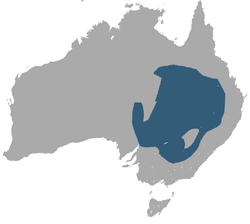Ecology & behaviour
Diet
The narrow-nosed Planigale are generalist insectivores, able to thrive and with a diet that reflects the available prey of their environment. [6] Their diet mostly consists of arthropods including beetles, centipedes and spiders, but can also include reptiles such as small lizards.
Habitat
The narrow-nosed Planigale prefers an open less densely vegetated area (Read, 1987). [6] They can often be found in tussock grassland and low shrubland with cracking clay soils so as to inhabit the soil cavities. (Moss, 1988) [7] Plant height has also been recorded as positively associated with an abundance of P. tenuirostrist. [6]
Behaviour
Unlike other Planigale species, the narrow-nosed Planigale is nocturnal in both summer and winter (Read, 1989) [8] spending only minimal bursts of activity. Research has recorded past short-term activity cycles as 1 hr 25 min in summer and 2 hr 56 min in winter (Read, 1989) [8] Narrow-nosed Planigale surface from the cracks to hunt during the night or stay within these cracks clinging to the vertical sides. [4]
Lifecycle & reproduction
Breeding season runs from July to Mid-January and coincides with food availability during Spring & Summer (Read, 1984). Females have 12 teats and a pouch. Females reach their sexual maturity (for reproduction) on average at 240 days. Females are only in heat (Estrus) for one day, on a 33-day cycle (Read, 1985). In males, the process of sperm production (spermatogenesis) begins in July and ends the following March(aspermatogenesis). The average gestation period lasts just 19 days. The young detach from the teats at a month after birth and mothers begin weaning the young at three months (Read, 1985) [9] In captivity females give birth to two litters with an average of six young annually, [10] but in the wild it is more likely only a single litter will be produced (Read 2008). [11]
Threats to survival
Population densities tend to fluctuate from year to year, however, despite some declines in distribution, this species appears stable. [4]
Habitat degradation
There appear to be no major or widespread threats to the narrow-nosed Planigale species. Localised threats and population declines occur in the form of habitat conversion or destruction, particularly for agricultural use. [2]
Predators
As a result of its habitat (below ground) and hunting habits (within soil cracks), it is protected from most larger predatory species (Moss, 1988).
Changes in rainfall
Research has postulated that fluctuations in rainfall affect the populations of Planigale gilesi and P. tenuirostris (Read, 1988), [7] however little other research has been done into this to confirm whether it is rainfall alone, or the byproduct effect on resources.
This page is based on this
Wikipedia article Text is available under the
CC BY-SA 4.0 license; additional terms may apply.
Images, videos and audio are available under their respective licenses.



